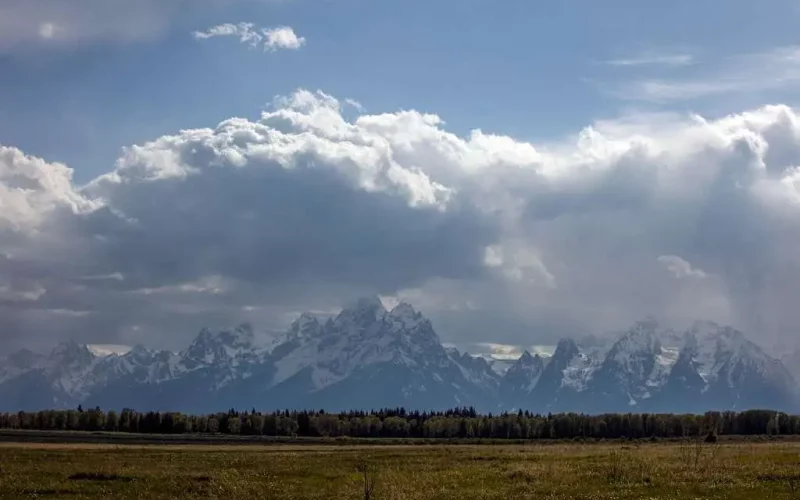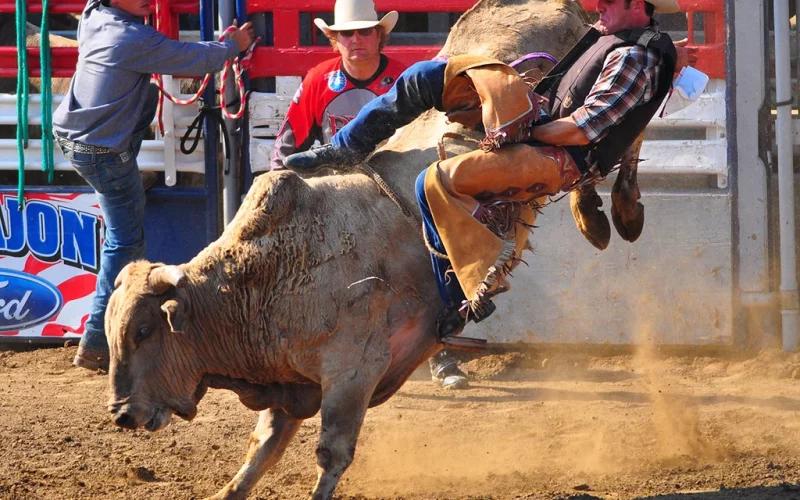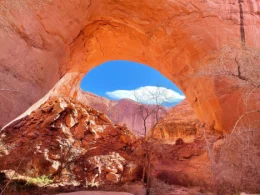As I was researching the weather forecast for the Tetons, I was excited for what looked like a clear day of hiking ahead of me. I had a 22 mile loop planned out, going up and over a high mountain pass. I knew it was going to be a long day for the legs, and I thought I was in luck for the first clear day in nearly a week out in Grand Teton National Park. All of the weather forecasts I looked at predicted clear blue skies all day; I felt so fortunate that my biggest mileage day in the Tetons looked like there wouldn’t even be a cloud in the sky.
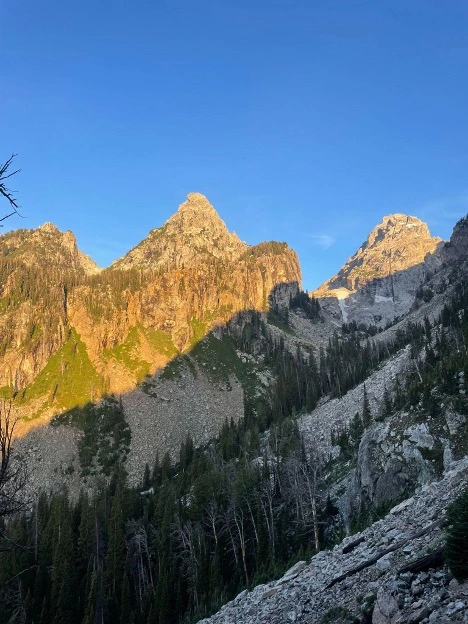
I knew I had about five miles of exposed terrain above tree line, so I was making sure to keep an eye on the weather and cloud formations so I wouldn’t encounter any thunderstorms on that pass. I was hoping to get this stretch of the trail done before noon, as daily afternoon thunderstorms (monsoons) are quite common out in the Rocky Mountains, even if it’s not in the forecast. I woke up at 6:00 that morning, still checking my weather to see if any developments had occurred overnight.
The conditions looked perfect for me, and as I was driving into the Park, I got to get my real first good look at those mountains since I’d been there, as they’d been in the clouds for the days prior. Looking up at the Grand for the first time felt like looking at Everest, not that I’ve been to Nepal or anything, but the point is I was blown away by the stature and dominance of the mountain. I couldn’t wait for my hike that day, eager to see what the Tetons could show me and teach me on this treacherous hike.
I started at about 7:30 that morning, with the early morning sun shining through the trees and a cool breeze to welcome me into this marvelous range. About thirty minutes into my hike, I started experiencing an on and off light rain for nearly an hour. It was nothing terrible, and honestly it felt really nice, but it did make me hyper aware that this weather can change at any moment, and I had a gut feeling it was going to persist as my hike went on. Right as I was approaching the end of the tree line, at about 10:00 am, I saw some darker clouds rolling in over the ridge, and I immediately got dumped on.
I sat underneath the last big Subalpine Fire before the treeline disappeared for thirty minutes to wait until the storm could pass. I had enough service to check the weather for the specific peak I was crossing, Paintbrush Peak, and it said it was going to clear up in the next hour. I waited until the rain stopped, but I knew I was still taking a risk going to cross the mountain pass. I was able to see the bright blue sky again and felt safe going over the pass, especially since I hadn’t heard any thunder and the clouds didn’t look like heavy storm clouds. As I reached the top of the pass, I got slapped with piercing hail for my three miles descending below the alpine terrain. Luckily, I never encountered thunder and lightning, but I was ready to run down the mountain and into the trees if I saw it coming.
I was visiting Grand Teton National Park after living in Northern California for the preceding three months, where I never once had to worry about rain or storms. I have lived in the mountains of Colorado for a few years now, so I’m used to the regular monsoons, but what I experienced in the Tetons that week was far different than anything before.
My older brother lives in the area, and said this year was nothing like he’s ever experienced weather wise. I have heard the same from my people in Colorado this summer, with crazy flash floods almost sweeping my partner’s car off the street. I’ve been doing some research about why this summer has been getting increasingly more intense as the months go on, and I’ve found some really interesting science behind this.
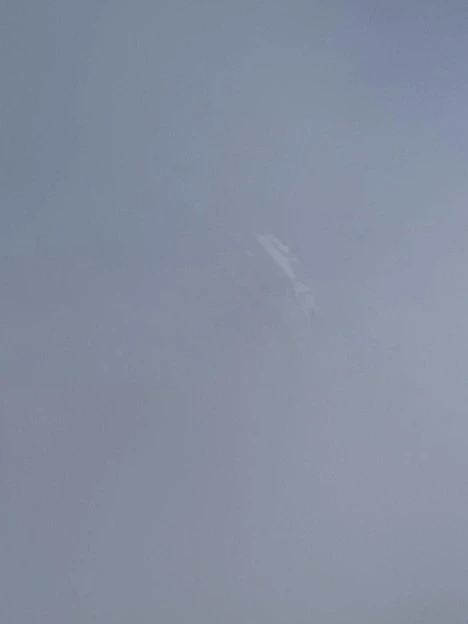
Table of Contents
2023 is an El Niño Southern Oscillation (ENSO) year, but what does that really mean?
This past Spring kicked off an El Niño year that is likely to prevail into this coming Winter, meaning warmer temperatures and more frequent heavy storms. These weather conditions are determined by the climate patterns across the Pacific Ocean. Normal conditions mean that trade winds are flowing from East to West across the Pacific. In an El Niño year, the trade winds push the warm water East, which simultaneously causes a strong and southward shift of the jet stream across North America and lower surface air pressure, leading to more rising air and clouds and other climate phenomena. Specifically, the Southwest regions of North America will find more storms and flooding, whereas the Pacific Northwest is likely to have much warmer and drier conditions. These patterns are shown through my time spent in Grand Teton National Park, as well as the heavy wildfires in Western Canada. In the simplest terms, La Niña is the reverse of this, where trade winds are blowing the warmer water West over the Pacific, and the reverse of the weather patterns happens in each region. Typically, El Niño lasts about nine to twelve months, occurring about every three years; La Niña will typically last one to three years uninterrupted. They don’t follow a consistent or predictable cycle though.
How Does Climate Change Affect El Niño?
Every time an El Niño event occurs, it seems to become much more extreme and unpredictable, as I recently learned while hiking in the Tetons. It is also occurring more frequently, most likely due to the warming planet and greenhouse gas emissions.
Although we can be glad that El Niño and La Niña events are part of a cycle of temperature increases and decreases, many scientists fear that this El Niño cycle could push global temperatures into an irreversible threshold. The warmer surface temperatures across the Pacific with increased evaporation also mean the ocean is losing heat to the atmosphere, where it is trapped by cloud cover. Additionally, this greater cloud clover means that the sun’s heat can’t be absorbed into the oceans, but in the atmosphere. It is predicted that the 2023 El Niño event will lead to an increase of a few tenths of a degree Celsius globally, a substantial amount for this already warming planet. Some scientists believe this may be the fourth hottest year on record.
El Niño on the Lives of Humans and Animals
The El Niño cycle takes a big toll on marine life in the Pacific. During the normal La Niña phases, upwelling brings up nutrient-dense cooler water from ocean depths to the surface. This means more phytoplankton along the coast for fish to feed on. Currently, this phenomena cannot occur, as the warmer surface temperatures suppress the nutrient-rich waters from reaching the coast. Therefore, there is less food for marine life, and less fish for human consumption as well. With the depletion of fish in the sea, there will also be less seabirds as they won’t have as much food to feed off. The warmer temperatures also cause bleaching in coral reefs, leading them to a risk of starvation.
To look at the effects on a small scale, reptiles in the Galapagos Islands are facing great risk due to the current cycle. Just as there is less phytoplankton on the coast, the warmer water temperatures mean less algae production. Many animals rely on algae as their main food source, such as black marine iguanas in the Galapagos. The increased flooding has additionally affected the local turtles, as their nests are being destroyed by floods and they can’t reproduce.
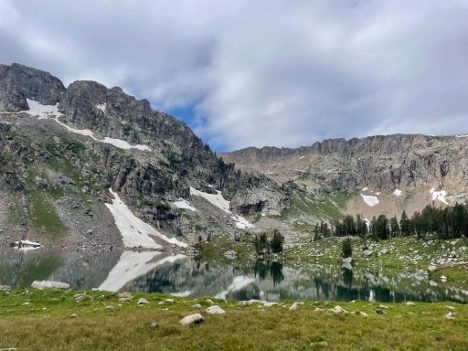
There will also be more hurricanes in the Pacific, affecting small islands like that of Hawaii and others. These tropical cyclones are not only damaging to the natural habitats and properties, but to human lives as well.
This past Winter had one of the heaviest precipitation rates in Western North America in many years, but the current El Niño cycle is likely to continue on into the following Winter. Another heavy Winter in Western North America could bring even more devastation, and extreme flooding to places like California and beyond.
There will be long term effects of the 2023 El Niño event, such as to our food supply, health, water management, and the environment. We are breaching into uncharted climate territory, and need to be ready for what is to come. There are going to be much greater effects than simple hikers like me who don’t wish to venture into the rain. My hike in the Tetons was a wakeup call for me to be aware and prepared for what is to come.

